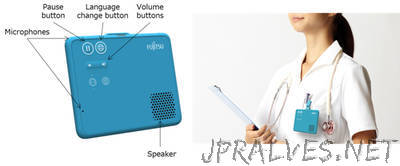
“No need to physically manipulate the device to communicate while care giving in hospital wards and a variety of other situations
Fujitsu Laboratories Ltd. today announced the development of the world’s first wearable, hands-free speech translation device, suitable for tasks in which the users’ hands are often occupied, such as in diagnoses or treatment in healthcare. In recent years, with an increase in the number of visitors to Japan, more and more non-Japanese patients are going to hospitals, creating issues in supporting communication in multiple languages. In 2016, Fujitsu Laboratories developed hands-free technology that recognizes people’s voices and the locations of speakers, and that automatically changes to the appropriate language without physical manipulation of the device. That same year, it also worked with the University of Tokyo Hospital and the National Institute of Information and Communications Technology (NICT) to conduct a field trial of multilingual speech translation in the medical field using stationary-type tablets. Based on the results, Fujitsu Laboratories learned that, as there are many situations in which healthcare providers have their hands full, such as when providing care in a hospital ward, there was a great need for a wearable speech translation device that could be used without being physically touched. In order to expand the usability of multilingual speech translation, Fujitsu Laboratories has developed the world’s first compact, wearable, hands-free speech translation device by developing technology to differentiate speakers using small omnidirectional microphones. This is possible through an ingenious modification of the shape of the sound channel, and by improving the accuracy of speech detection technology that is highly resistant to background noise. Use of this device is expected to reduce the burden on healthcare providers whose hands are often constrained by other tasks. Fujitsu Laboratories will evaluate the effectiveness of these newly developed translation devices in healthcare situations as part of a multilingual speech translation clinical trial(1) being carried out jointly with Fujitsu Limited, the University of Tokyo Hospital, and NICT, with the new devices being deployed in November 2017.”
